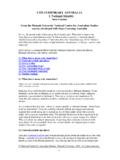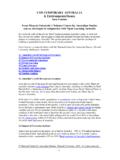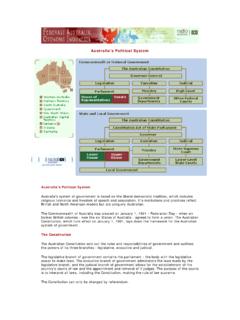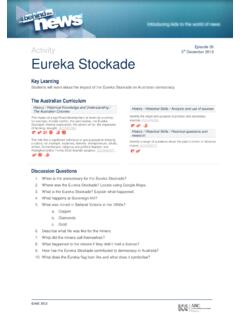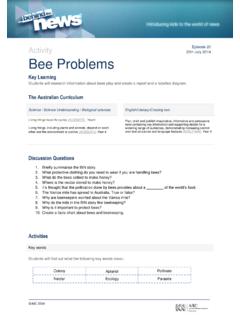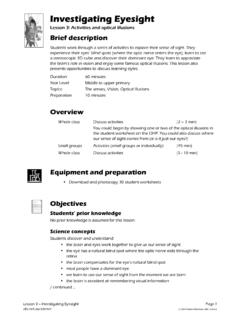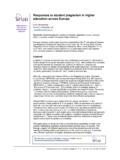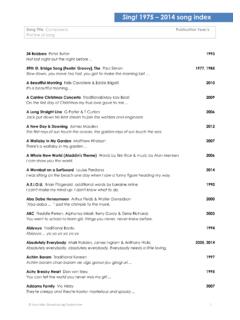Transcription of Introduction to Australia's National Electricity market
1 ELECTRICITYAEMO GPO Box 2008 Melbourne VIC 3001 Website: INFORMATION CENTRE Telephone: 1300 361 011 ISBN 0-646-41233-7 AN Introduction TO AUSTRALIA S National Electricity MARKETJULY 20103 ELECTRICITYD isclaimerThis document is made available to you on the following basis: (a) Purpose - This document is provided by the Australian energy market Operator Limited (AEMO) to you for information purposes only. You are not permitted to commercialise it or any information contained in it.(b) No Reliance or warranty - This document may be subsequently amended. AEMO does not warrant or represent that the data or information in this document is accurate, reliable, complete or current or that it is suitable for particular purposes.
2 You should verify and check the accuracy, completeness, reliability and suitability of this document for any use to which you intend to put it and seek independent expert advice before using it, or any information contained in it. (c) Limitation of liability - To the extent permitted by law, AEMO and its advisers, consultants and other contributors to this document (or their respective associated companies, businesses, partners, directors, officers or employees) shall not be liable for any errors, omissions, defects or misrepresentations in the information contained in this document, or for any loss or damage suffered by persons who use or rely on such information (including by reason of negligence, negligent misstatement or otherwise).
3 If any law prohibits the exclusion of such liability, AEMO s liability is limited, at AEMO s option, to the re-supply of the information, provided that this limitation is permitted by law and is fair and reasonable. 2010 - All rights Electricity Supply Industry 2 The National Electricity market 4 The Australian energy market Operator 5 National Electricity Law and Rules 6 The Spot market 7 Key Parameters for NEM Operation 8 Operating the NEM 9 Ancillary Services 14 Inter-regional Trade 15 market Forecasts 17 Full Retail Competition 19 Registered Participants 19 Financial Contracts for Electricity 20 Alternative Generation Technologies 22 AEMO and the Environment 22 Regulatory Arrangements 23 Glossary 24 National Electricity market 12 Sectors of the Electricity supply industry are
4 Involved with the generation, transmission, distribution and retail sale of Electricity . Australia s social, industrial and commercial success depends on the reliability of the Electricity supply. In this way, the industry contributes significantly to the National economy. What is Electricity ? Electricity is a form of energy produced by the flow of electrons in a substance known as a conductor. The best conductors are metals such as copper and aluminium, and are commonly used in electrical wiring. energy exists in many forms. Electricity is a secondary energy source as it is produced by the conversion of other energy sources like the chemical energy in coal, natural gas and oil.
5 Other primary sources of energy , like the sun and wind, are increasingly being used to produce Electricity . A quantity of energy can be changed or converted, but can never be created or destroyed. Electricity can be converted readily to heat and light and used to power machines. It can also be transported with relative ease. These characteristics make Electricity a convenient and manageable form of energy , and contribute both to its value as a commodity and its versatility as a source of power. A unit of power is referred to as a watt. The number of watts, or wattage, of an electrical appliance indicates the rate at which the appliance converts electrical energy to another form of energy such as heat or light.
6 One watt is equivalent to one joule of work per second. Both the electrical pressure (voltage) and the number of electrons flowing (current) determine the electrical power or rate of energy conversion. A 60-watt light globe uses 60 watts of Electricity to produce light, and a typical electric kettle uses 2400 watts to produce is Electricity Produced? Electricity can be produced by either chemical means or mechanical action. Electricity produced by chemical means relies on a flow of charged particles from cells in a battery. While this type of Electricity has some very important applications in modern society, it is an expensive production process and can meet only limited, specific requirements for Electricity .
7 The generators in modern power stations produce Electricity by the mechanical action of large, powerful magnets that spin rapidly inside the huge coils of conducting wire driven by steam, gas or water turbines. More than 90 per cent of Australia s Electricity production relies on the burning of fossil fuels - coal, gas and oil. The chemical energy stored in these fuels is used to heat water and produce steam. The steam is then forced under great pressure through a turbine that drives a generator to produce Electricity . The complete process involves the conversion of chemical energy to kinetic energy to electrical energy .
8 In a similar way, the kinetic energy of falling water drives turbine blades to produce electrical energy at a hydro- Electricity plant, and the kinetic energy of wind drives the blades of a wind-power turbine to produce Electricity SUPPLY INDUSTRY UNITS EXPLAINEDOne megawatt (MW) is equal to one million watts (W).One gigawatt (GW) is equivalent to one thousand megawatt hour (MWh) is the energy required to power ten thousand 100 W light globes for one hour. A 100 MW generator will power one million 100 W light globes simultaneously. A 600 MW generator has sufficient capacity to service 200,000 domestic is Electricity Transported?
9 Electricity travels along a conductor at close to the speed of light. When an appliance is switched on, power is instantly transmitted from a power station to the appliance. Although this occurs instantaneously, a specific sequence of events takes place to ensure the delivery of the required Electricity . A transformer converts the Electricity produced at a generation plant from low to high voltage to enable its efficient transport on the transmission system. When the Electricity arrives at the location where it is required, a substation transformer changes the high voltage Electricity to low voltage for distribution.
10 Distribution lines then carry low voltage Electricity to consumers who access it through the power outlets in homes, offices and Electricity MARKETE nergy exists in many forms. Electricity is a secondary energy source as it is produced by the conversion of other energy sources like the chemical energy in coal, natural gas and oil. Other primary sources of energy , like the sun and wind, are increasingly being used to produce OF ELECTRICITYP ower plant generates electricityTransformer converts low voltage Electricity to high voltage for efficient transportSubstation transformer converts high voltage Electricity to low voltage for distributionHomes.
